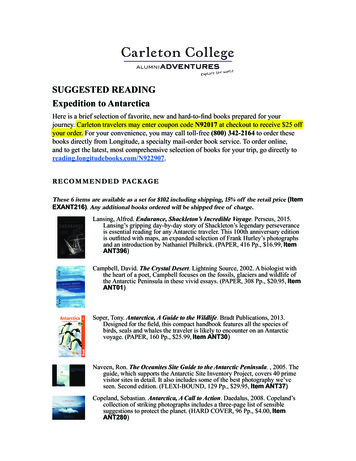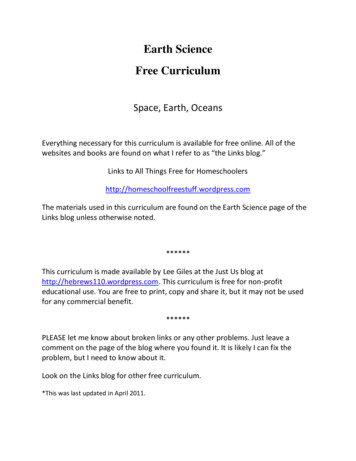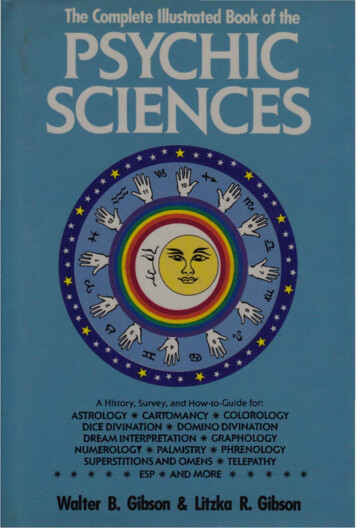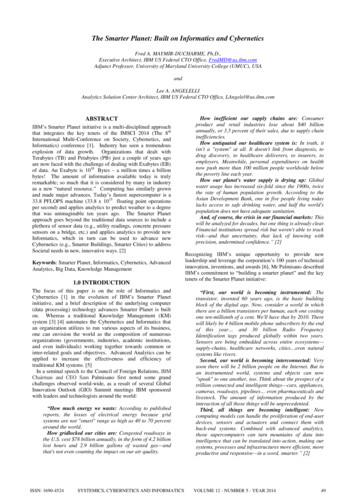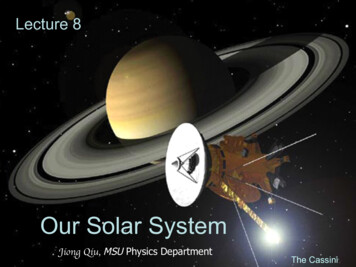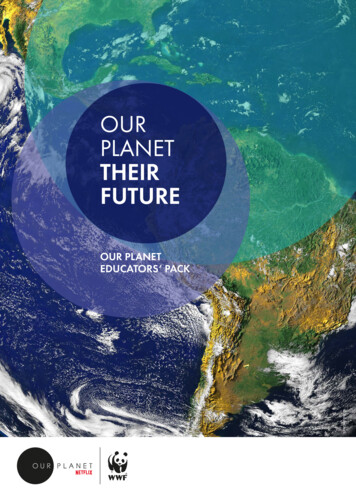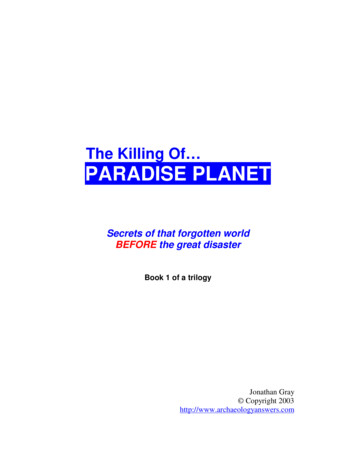
Transcription
The Killing Of PARADISE PLANETSecrets of that forgotten worldBEFORE the great disasterBook 1 of a trilogyJonathan Gray Copyright 2003http://www.archaeologyanswers.com
Illustration CreditsIf I failed to credit any illustrations reproduced inthis book, I offer my apologies. Any sources omittedwill be appropriately acknowledged in all futureeditions of this book.About the authorJonathan Gray has travelled the world to gather dataon ancient mysteries. A serious student of pre-history,he has investigated numerous archaeological sites, andhas also penetrated some largely un-explored areas,including parts of the Amazon headwaters.Other books by Jonathan GrayDead Men’s SecretsSting of the ScorpionThe Ark ConspiracySurprise WitnessThe Corpse Came BackCurse of the Hatana Gods64 Secrets Ahead of UsBizarre Origin of Egypt’s Ancient GodsThe Lost World of GiantsSurprise WitnessThe Corpse Came BackDiscoveries: Questions AnsweredThey VanishedSinai’s Exciting SecretsCurse of the PharaohsThe Man Who Needed Two GravesThe Big Dating Blunder2
CONTENTSPAGE57PrefacePrologue1Sudden Change CITY UNDER THE SEA102The first world (a) ANTARCTICA’S PALM BEACHES193The first world (b) –THE WEATHER MAN WHO GOT IT WRONG294The first world (c) LOBSTER AS BIG AS A MAN345The first world (d) IF A SNAKE BITES YOU416The first world (e) ANCIENT NUCLEAR REACTOR487The first world (f) –COULD YOU REALLY LIVE TO BE 600?558The first world (g) JUDGMENT DAY679Flood traditions (a) WORLD IN SHOCK7910 Flood traditions (b) A CANNIBAL’S TALE9511 Worldwide flood (a) THE FLOOD THAT REALLY NEVER WENT AWAY10612 Worldwide flood (b) WHY HANK GASPED1183
13Noah’ s Ark queries NO ROOM FOR ERROR12614Ages in chaos DATING SHOCK14615How old is the earth? THE COVER-UP15816Have all races appeared since Noah? NOT ENOUGH TIME?172Epilogue181Appendix185Index1894
PREFACEIt was Black November. Two billion or more people, with theirastonishing technology, vanished from the face of the earth. This lost superrace beat us to the moon, computers and nuclear war.In that popular book Dead Men’s Secrets, Jonathan Gray uncovered somestartling information about this super civilisation that was wiped out in acosmic disaster.More astonishing discoveries continue to surface and confirm the basicthesis of that book.It is now time to take a very close look at the big event itself the disasterthat minced to atoms that advanced world.This is not intended to be a detailed reference work, but a simple, straightforward explanation of the main factors involved. For the reader who wantsto dig deeper, there is an abundance of further information available.But first a note concerning the date of that event. When Dead Men’sSecrets was released, the author was prepared to go along with the commonestimate that the post-Flood civilisations of Egypt, Sumeria, etcetra, sprangup suddenly around 3000 B.C.Nevertheless, it was felt necessary to state (Dead Men’s Secrets, page 349)that “the precise time may be subject to revision.” That prediction hasproven justified. New research requires that the date of the Deluge berevised closer to our time, to 2345 B.C. Numerous and varied methodssupport this revision.**Details appear in Book 3 of this series, The Corpse Came Back.5
As a consequence, the rapid post-Flood rise of the new civilisations wouldrequire similar adjustment.Dates from c.2250 onward are not affected. The date of the Babel worldgovernment collapse is as solid as ever. It will be seen, however, that thereis a considerable shortening of history between the Deluge disaster and theBabel episode.The estimated number of active volcanoes at that time should also bechanged - drastically increased, in fact.It will be noted that the above adjustments are in the realm of numbers, notin the facts themselves.Welcome to a new adventure in discovery.6
PROLOGUE“Porrett is coming out of his apartment GET READY.”“The wind’ s wild. It’ s gonna be hard to hit him!”“This is our only chance. DON’ T MISS! NOW!”A fast aim skidding tyres CRASH “Let’ s get outta here!”George Porrett struggled to his feet, flicking off the mud. “Boy, was thatclose!” he thought. “They missed me again.” He glanced upward.Somehow Porrett felt protected. ‘THANK YOU,” he breathed.“ Hello, George. You’ re looking shaken. Come in. Come in. Whatis it?”“There’ s been another attempt on my life.”“Just a minute. Betty, call Ray and Ken. Get them in right away.”“ It’ s open warfare, guys. These photographs are hot.discovery. They’ re out to silence us ”This wholeMuch of the data had been known for a while. But now it threatened toblow sky-high some reputations. Careers and big money were at stake. Allvery upsetting. One or two persons were getting so strung up about it, theywould do anything. Yes, even kill.This book is about LIFE and DEATH, LOVE and HATE. The big stuff.It’ s about THAT discovery - a haunting secret from our past.7
You might wonder how the distant past could ever arouse men to threateneach other now. But, as you read on, you may understand why somepeople currently consider this so important.Briefly, this is the discovery DISCOVERED – Buried alive! From Australia to Alaska:billions of corpses of animals and people. Violently mixed: large animals ofDEEP sea and land, TOGETHER! Elephants and tropical palm trees:SUDDENLY entombed in ice.TODAYour earth is spoiled and mostlyuninhabitable. But this was notalways so.THERE WAS A TIMEwhen everything lived under a giant,protective canopy. The atmosphere wastemperature-controlled. It was aparadise planet.THEN SOMETHING HAPPENEDIt was sudden. A whole world vanished.This sudden disappearance is like amystery thriller with the last pagestorn out except that THERE ARE ALSOLegends – racial traditions –that speak ofsuch an event. And they recall what reallyhappened.BUT THE REAL SHOCKERIs the physical evidence. The killing of awhole planet is the most astonishingtrue story you’ll ever hear.8
FACT MYSTERY ADVENTURE In Dead Men’ s Secrets, an investigation was made into lost cities of thedead and the surprising discoveries they held. We explored our planet’ sjungles, desert sands and seafloor to extract forgotten secrets of atechnology that had vanished. There emerged tantalising hints of a lostsuper race that had been wiped out in some cosmic disaster.Now it’ s time to peer closer into that mysterious lost world. We shalldiscover the event that snuffed it out. And its impact on those whosurvived and on their descendants. Indeed, as we shall find, shock wavesfrom this event are still being felt today. Dead men will talk to us. Makeno mistake. The implications are dynamite.Nevertheless, our quest is not based on ancient texts and reports, but onaccepted scientific discoveries. There are recently discovered objects thatcannot be dismissed - namely artefacts and corpses, entombed in theviolently damaged structure of the earth’ s crust. Some are in museums.These speak in thundertones of a disaster which was sudden and total.Stand by for adventure - gigantic adventure.Come with me now, far back into the centre of the Great Unknown. Ourdestination: a strange planet (albeit our own), 5,000 years in the past.We shall look in upon this super world that vanished so completely wethought it never existed.Let’ s begin.9
1Sudden changeCITY UNDER THE SEA“ It’ s too bizarre!”I stared at Doug. Was he nuts?“ But it’ s true,” he repeated. “ He was found here. Poor thing. Had nochance. Whatever happened, it was all so sudden. He was snap-frozen.”Doug cracked his knuckles. “ just like that!“ Didn’ t even have time to swallow. When they found him, the freshchewed veges were still on his tongue. Fresh food in his stomach stillthere, undigested.“ And here - fresh, ripe plums, still on the branches. Snap frozen, I tell you.Then suddenly buried beneath hundreds of feet of muck.“ And over here ”I caught Doug’ s excitement. Bent over the map, jumping from place toplace, he pointed out the spots.Now he was in Alaska, now in Siberia Antarctica too.‘BUT THEY’ RE TROPICAL’ ” I protested. “ What are tropical animalsand plants doing frozen in ice?”“ Not ice,” corrected Doug. “ It’ s FROZEN water-laid muck.”Yes, it was all so bizarre. But true! There was the evidence! What couldhave happened so suddenly that day long ago?It was time to find out 10
A SUDDEN CHANGE: PHYSICAL EVIDENCEAs my investigation proceeded, it soon became clear that there wasevidence for an ancient globally warm climate - from pole to pole. Thatitself was astonishing enough. But the next discovery was to be no lessstartling.It must have changed SUDDENLY. So suddenly that tropical animalswere snap-frozen in mid-motion, to be preserved to this day withundigested food in their stomachs!Something deadly and very sudden wiped out the population, changed theclimate, and REVERSED the land and water distribution of this planet.Did you get that? I’ ll repeat it.There is evidence that our planet - this planet Earth of ours - was oncesubtropical from pole to pole and that - believe it or not - the SEA LEVELstood 2 or 3 miles LOWER than now.There is evidence that something deadly and very SUDDEN changed theclimate in a flash, reversed the land and water distribution of the globe andvirtually wiped out the world’ s population.Yes, I know somebody will say I’ m off my rocker. But before you do, letme state that THERE IS PERSUASIVE EVIDENCE THAT THE WORLDWAS ONCE VASTLY DIFFERENT.And compelling also is the evidence that WHATEVER CHANGED ITOCCURRED SUDDENLY.A DAMAGED PLANETIn fact, I have rarely investigated anything I thought was more factual.I am now convinced that not so long ago there occurred a waterycatastrophe of such magnitude that the earth is still reeling from itsonslaught.11
This global deluge explains why today’ s world is far from perfect. Weinhabit a planet that has been DAMAGED and IMPOVERISHED, stillsuffering the effects of a worldwide disaster.You will notice from the graph below that water covers almost threequarters of our planet’ s surface.Of the 30 percent area that is land, less than half is suitable for habitation atpresent. In other words, only 18 percent of our planet’ s surface is nowsuitable for human habitation.Large areas now under perpetual desert or ice were once lush, fertile andinhabited. Large areas now under the sea were likewise habitable. I shallgive you evidence of this.Then something happened suddenly. It changed everything.Yes, we are now living on a planet that is DAMAGED andIMPOVERISHED.But this is not all. The earth after the Disaster was not only considerablyreduced in land area. But even in this SHRUNKEN land surface area, thefertility of the soil and the natural resources necessary for human progressare UNEQUALLY distributed and LARGELY BURIED.12
But this was not so before the Great Flood. There! I’ ve said it. I’ ve saidsomething that is anathema to the established theory of world history. I’ vementioned the GREAT FLOOD.DROWNED LANDThe Hitler war was now three years in the past. The Swedish research ship“ Albatross” had just returned from a peaceful reconnaissance in the SouthAtlantic.Had you peeped through a lattice window in a little house outsideStockholm, you might have seen two men, one of them bearded, huddledacross a table, engaged in lively talk.One of them, in fact, looked almost wild-eyed. But, knowing him as awell-balanced, sober man, you would have to admit that whatever it wasthat now had him so excited must be something extraordinary.“ I swear to you, it’ s incredible! Do you know, we were sounding theseabed 700 miles east of Brazil. And we brought up core samples of freshwater plants! Can you believe that! And do you know how deep theywere? Three thousand metres! These samples actually contained microorganisms, twigs, plants and even tree bark.”13
The speaker was Professor Hans Pettersson, who had led the expedition.“ I cannot explain it - except that that land must have sunk on the spot.”ANOTHER DISCOVERYWithin a similar time frame, discussion was hot in London. Coral hadbeen recovered from depths of over 3,000 feet (1,000 metres) in midAtlantic Ocean sites. Now we all know that coral grows only close to sealevel.So in London, England, someone else was making a chilling diagnosis:“ Either the seabed dropped thousands of feet or the sea rose mightily.”AND STILL ANOTHERMeanwhile, at Columbia University in the U.S.A., Professor MauriceEwing, a prominent marine geologist, was reporting on an expedition thathad descended to submerged plateaus at a depth of 5,000 feet.He was being interrogated. “ Tell us, what did you find?”“ It’ s quite amazing,” was his response. “ At five thousand feet down, theexpeditioners discovered prehistoric beach sand. It was brought up in onecase from a depth of two miles and the other nearly three and one halfmiles, far from any place where beaches exist today.”“ How far from land was this?”“ One deposit was 1,200 miles from the nearest land.”As we all know, sandy beaches form from waves breaking on the edge ofthe coastal rim of the seas. Beach sand does not form deep down on theocean bottom.Then Dr. Ewing dropped his bombshell: “ Either the land must have sunktwo or three miles or the sea must have been two or three miles lower thannow. Either conclusion is startling.” (M. Ewing, “ New Discoveries on the Mid-Atlantic Ridge,” National Geographic Magazine, Vol. XCVI, No.5 - Nov. 1949)14
WHAT THIS MEANSThese facts can be interpreted in only two ways: either there was a mightyocean bed subsidence (unexplainable by orthodox science), or a huge(likewise unexplained) addition of water to the ocean.Let’ s briefly consider these.1.Sudden subsidenceOtto Muck draws attention to the sharp, fine profiles of much of thelandscape that is now drowned by the ocean. He notes:“ The sharp, fine profiles would have been eroded, and the lava covering theocean floor would have decayed if all this rocky terrain had been immersedin sea water for more than 15,000 years. Chemical forces are verydestructive, but mechanical forces are equally so. Sharp edges and pointscan be ground down and blunted by abrasion, erosion, and the action ofwaves. But the entire seabed below the present surf zone has retained itssharpness of profile. Had the subsidence taken place gradually, chemicaland other forces would have ground down this sharp profile within a fewhundred years.” (Otto Muck, The Secret of Atlantis, p.146)If the land had sunk slowly, even the surf would have worn away theseprofiles. No, it was a rapid subsidence, if a subsidence it was.This sudden collapse of an area covering many millions of square milesmust have been accompanied by violent seismic and volcanic activity. Theevidence does not support a gradual sinking, but rather a cataclysmic event.15
Such subsidence is perfectly in keeping with the centuries-long adjustmentsthat occurred after the Great Flood trauma. These will be explained indetail in the third book of this series.2.Pre-Flood sea level lowerHowever, some of the data strongly suggest that the sea level actually wasseveral thousand feet lower than at present - that there was LESS WATERin the ocean at one time. These discoveries suggest that we are uncoveringevidence of a former sea level!But this would call for a relatively sudden increase of 30 percent in thevolume of the ocean. The compelling question is, WHERE DID THISWATER COME FROM? Few geologists can bring themselves to answerthis.Obviously, melting ice sheets could never have contained enough water toraise the ocean level thousands of feet. So we can forget melting ice sheetsbeing the cause.CITY ON THE SEABED?Now for another surprise. This time the excitement was in the Pacific. Theyear was 1965. A research vessel named “ Anton Brunn” was investigatingthe Nazca Trench, off Peru.The sonar operator called for the captain.“ I don’ t know what to make of this,” he murmured. “ Around here, theocean floor is all mud bottom. But just take in these sonar recordings unusual shapes on the ocean floor! I’ m puzzled.”16
“ Better lower a camera,” came the order.At a depth of 6,000 feet a photograph revealed huge upright pillars andwalls, some of which seemed to have writing on them. In other nearbylocations, apparently artificially shaped stones lay on their sides, as thoughthey had toppled over.The crew rubbed their eyes and kept staring. Could this really be? theremains of a city under a mass of water more than a mile deep!Was this a city that had been overwhelmed suddenly by some giganticdisaster? And now it was buried under 6,000 feet (2,000 metres) of ocean?Water which never went away. Thus begins our investigation of a lost world - one which was like aparadise, in many ways. It was different beyond our wildest dreams. Yet itwas a REAL WORLD. As real as ours.In the next three chapters we shall probe its treasures, peer into itsmysteries and uncover a few of its tantalising secrets. Are you ready?Let’ s sneak back in time 17
A SUDDEN CHANGE - SummaryA ONCE DIFFERENT WORLDThere is evidence that our planetwas once subtropical from pole to pole. Moreover, there was more land and the sea level stood 2 or 3 miles lower than now.A DAMAGED PLANET TODAYWe now inhabit a world that isdamaged and impoverished, still suffering the effects of some worldwidedisaster.A SUDDEN CHANGE OCCURRED There is evidence that somethingdeadly and very sudden changed the climate in a flash, reversed the landand water ratio and virtually wiped out the world’ s population.REMAINS UNDER THE SEA Some intriguing finds on the seabed testifyto this sudden change that interrupted human history.18
2The first world (a) -ANTARCTICA’S PALM BEACHES“ Can you believe it!” shouted Giselle. “ Look, look! There’ s a waterskiier!”“ Can’ t be!” I retorted.“ Yes, yes, look!”The very word “ water-skiier” was enough to awaken a stampede.Everyone crammed against the starboard windows. Our plane dipped downto a thousand feet. Sure enough, behind a powerboat, on a small stretch ofwater skimmed some guy in a wet suit.“ It’ s minus sixty out there!” someone exclaimed.There was good reason for the fuss. This was Antarctica, you see. Justdown the coast a 200 mile-per-hour blizzard was raging, whipping up adeadly ice cloud. But here, in frozen sunshine, skiied a Frenchman.I recalled with amusement that some years ago the French government hadpassed a law for its Adelie Land territory in Antarctica, exempting itsinhabitants from military service - when its only inhabitants were penguins!Emperor penguins exempt from military service! (picture: Junior World Encyclopedia)19
Now Antarctica had a French research base. And we knew, dropping outof the sky unannounced, that we were their first visual contact with theoutside world in six months.Antarctica Between the stark white ice cliffs and the black of the oceanbelow us appeared a ribbon of milky blue, where the ice plunged under thewater. It was so beautiful, I just gasped.Yet it is a bleak and deadly land. That water-skiier could not dry off undera tropical palm.Not any more.A WORLDWIDE WARM CLIMATEThere is definite evidence that our planet once presented a warmsubtropical climate from pole to pole. Corals, which grow only in warm waters (of at least 20 degreesCentigrade) once grew near the poles.Canada, Alaska,Newfoundland, Greenland and Spitzbergen contain fossil coral. Coal seams are also found near the poles. The vast coal beds aresimply fossilised remains of trees and plants. The remains of animals now confined to warm regions are found allover the earth.20
Vegetation and animals Antarctica: In 1976, an Italian expedition discovered away belowthe ice - a petrified forest! Antarctica: The Admiral Byrd expedition found and photographed amountain composed totally of coal, indicating former lush growthhere. They also found ancient palm trees under the ice. Antarctica: In 1968, in the mountains of central Antarctica, anAmerican expedition came upon the jaw bone of a crocodile-likeamphibian (called a labyrinthodont), as well as skeletons of otheranimals - creatures that could have survived only in a warm to hotclimate. Similar finds were made again in 1986. Northern polar regions: Abundant remains of tropical animals havebeen uncovered in icy Greenland, Alaska and Siberia. In these same northern polar regions are numerous fossil trees:beech, myrtle, laurel, breadfruit, cinnamen, oak, walnut, banana,grape vines, and so on. And from a line north of Labrador across toAlaska: giant sequoias. Spitzbergen and Greenland now shiver in darkness for half of theyear and lie almost continuously under snow and ice. Yet a rich,temperate flora once covered these icy wastes in the Arctic Ocean.Fossil remains of magnolias, fig trees, palms, arborescent ferns(which are typically tropical) and animals from warm climates havebeen discovered also pines, firs, spruces, cypresses, elms, hazelsand water lilies. South polar region: Redwood forests are found buried under massiveice deposits. These towering giants (now typically found in thenorth-west of the U.S.A.) once flourished in many diverse parts ofthe world, as evidenced by many coal and fossil finds. Back to the Arctic Circle: Here are two very interesting islandgroups - the New Siberian Islands and the Spitzbergen Islands.Remarkable things have been reported by explorers who have beenthere. Immense frozen gravel mounts were discovered to haveentombed within them entire fruit trees with the fruit still on them.(D.G. Whitley, “ The Ivory Islands in the Arctic Ocean” , Journal of the PhilosophicalSociety of Great Britain, XII, 1910, p.49. Cited in Earth in Upheaval, by ImmanuelVelikovsky, Dell ed., 1955, p.19)21
In the New Siberian Islands, whole palm trees have been found, withtheir leaves and fruit.Tropical animals cannot live in icy water. Neither can sub-tropical plantsripen seeds and sow themselves in arctic conditions.ONE CLIMATE WORLDWIDEGeologist George McCready Price sums up the findings:“ If we listen to the unequivocal testimony of tropical plants and animalsfound away to the north and even within the arctic regions, we must declarethat geology knows only one climate until this sudden change came; andthis astonishing climate seems to have been practically uniform over theentire globe.” (George McCready Price, The New Geology. Mountain View, Calif.: PacificPress Publishing Association, 1923, p.654)Others concur:22
“ There is but one climate known to the ancient fossil world as revealed bythe plants and animals entombed in the rocks, and the climate was a mantleof springlike loveliness which seems to have prevailed continuously overthe whole globe. Just how the world could have thus been warmed all overmay be a matter of conjecture; that it was so warmed effectively andcontinuously is a matter of fact.” (Alfred Russell Wallace, The GeographicalDistribution of Animals, Vol 1. New York: Harper and Brothers, 1876, p. 277)“ When nearly the same plants are found in Greenland and Guinea; whenthe same species, now extinct, are met with of equal development at theequator as at the pole, we cannot but admit that at this period thetemperature of the globe was nearly alike everywhere.“ What we now call climate was unknown in these geological times. Thereseems to have been then only one climate over the whole globe.” (Sir WilliamDawson, geologist, cited by Samuel Kinns, Moses and Geology.Company, 1886, p.166)London:Cassell andPaleobotanist R.W. Chaney has shown from fossil plants that the climatewas slightly warmer near the equator and cooler near the poles. (R.W.Chaney, Bulletin of the Geological Society of America, 51 : 469-488. Scientific Monthly, 51 :489-499) There were these slight differences of latitude climate, but not thepresent zonal extremes. Overall, the climate of Planet Earth was mild andspringlike, perfect from pole to pole.This same warm global climateIN ALL SO-CALLED “AGES” OF STRATAWorldwide warm climate seems to be indicated in practically every socalled “ age” of rock strata. This is generally acknowledged. Whitcomb andMorris, in The Genesis Flood, cite testimony to this universally mild andwarm climate in the subdivision rocks of the Proterozoic (Azoic),Paleozoic, Mesozoic and Cenozoic “ periods” - that is, in practically all thestrata (pp.243-245). Basically all of these strata contain the buried life of theancient world.To many geologists this is perplexing.For example, von Engeln and Caster say concerning the Jurassic system:“ This universal tropicality is difficult to explain.” (O.D. von Engeln and KennethE. Caster, Geology. New York: McGraw-Hill Book Co., Inc., 1952, p.491. Whitcomb andMorris, pp.250-255)23
THIS ANCIENT WORLD EXISTEDWITHIN THE MEMORY OF MANKINDThere is good reason to believe that this world of perfect climate existedwithin the memory of the human race.The traditions of ancient humanity preserve the recollection of it.The ancient Chinese say that before the great Catastrophe, “ four seasonssucceeded each other regularly and without confusion. There were noimpetuous winds, nor excessive rains. The sun and moon, without everbeing clouded, furnished a light purer and brighter than now.” (Harold T.Wilkins, Mysteries of Ancient South America. Secaucus, N.J.: Citadel Press, 1974, p.30)Numerous ancient traditions contain details of the world “ before theFlood” , details which seem to stem from a common origin: the originalperfect state; a glorious land; long age spans; but growing disobedienceto spiritual laws - and eventual destruction.A VERY DIFFERENT WORLDThere is evidence that the entire earth was VERY DIFFERENT FROMTHAT WHICH WE NOW EXPERIENCE. It was a fabulous worldbeyond our power to imagine, much less to describe.There were no ice caps, no blizzards or rigors of arctic cold, no diseasebreeding heat of the tropics.There were no enormous wastelands. No deserts, barren patches, or bleakand sterile hills. The rocky features were hidden, everywhere covered witha mantle of fertile soil.MountainsThe mountain ranges were not the same high, forbidding walls as found inthe world of today. They were much lower, covered with vegetation, anddid not seriously interfere with the climate as do today’ s mountains.As E.H. Colbert noted in Scientific Monthly:24
“ The land was low and there were no high mountains forming physical orclimatic barriers.” (E.H. Colbert, “ Evolutionary Growth Rates in the Dinosaurs” , ScientificMonthly, August 1949, p.71)Ocean bedsConversely, the ocean beds were relatively shallower than now.Land distributionThere is evidence that the land and water areas were more evenlydistributed, with more land than water, perhaps very much more. The greatocean basins of today did not exist. Instead, the land was partitioned bynarrow seas and possibly shallow epi-continental seas (or marshes) in someregions of the earth.Have you noticed on maps how many of the contours of the continentalshores seem to fit like so many parts of a big puzzle? The distribution offossils indicates that the present continental masses were once joined.This has led to the idea among many scientists of “ continental drift” something speculated to have occurred over millions of years.But could it just as well have happened suddenly through some massiveupheaval of our earth?Today the study of the ocean floor confirms that the land masses HAVEbeen RIPPED apart.25
Yes, there used to be ONE continental land mass.The western continental shelf of Africa is believed to have fitted like ajigsaw piece into South America’ s eastern side. However, the smallamount of erosion of these matching lines suggests not millions of years,but a fairly recent ripping apart.Up to this point, we have considered only solid proven FACTS - facts thatcan be physically examined. Such as those from which we deduce a formerONE continental land mass, for example.But here, I shall introduce an ancient document. Would it surprise you tolearn that world history as given in the biblical book of Genesis agrees withthis? Originally, so the record goes, “ the waters were gathered into ONEplace” in contrast to the “ dry land.” (Genesis 1:9,10)Perhaps there is some truth in its “ myths” , after all!As we advance into our discovery of known FACTS concerning the lost“ paradise” world and what caused it to vanish, I believe we shall seeincreasing evidence that this often scorned book of Genesis does indeedcontain forgotten knowledge of the past.Without apology, therefore I shall occasionally mention its references tothat vanished world.Watering systemGenesis tells us that one central river system branched into four riverswhich extended and encircled areas of land. (Genesis 2:10-14)At least five “ pre-Flood” regions are identified - Eden, Havilah, Cush,Asshur and Nod.(Speculation is futile regarding the site of Eden’ s famous “ garden” ; theupheaval that changed the first world was thorough.)In those days no part of the land was too far from water; thus warm watercurrents were able to contribute to a mild climate everywhere. There wasless range between highs and lows.26
Extensive underground waterways served as a subirrigation system. Thewarm waters below the earth’ s crust emerged through great artesian springsto feed the surface rivers. (In Genesis 7:11 these are called “ the fountainsof the great deep” .)Remains of these subterranean streams have been discovered. We callthem geosynclines.No winds, storms or rainWe have noted the uniformly warm temperatures and the much gentlertopography of this original world.Winds and storms would have been impossible, since these result basicallyfrom interchange between hot and cold atmospheric conditions.Cyclonic winds did not occur, but there was, by implication, the presenceof gentle breezes.The great global air mass movements that sustain the present hydrologicalcycle would have been impossible. Heavy rains could never have occurred.Thus one can take seriously the statement in Genesis (ch.
Other books by Jonathan Gray Dead Men’s Secrets Sting of the Scorpion The Ark Conspiracy Surprise Witness The Corpse Came Back Curse of the Hatana Gods 64 Secrets Ahead of Us Bizarre Origin of Egypt’s Ancient Gods The Lost World of Giants Surprise Witness The Corps

